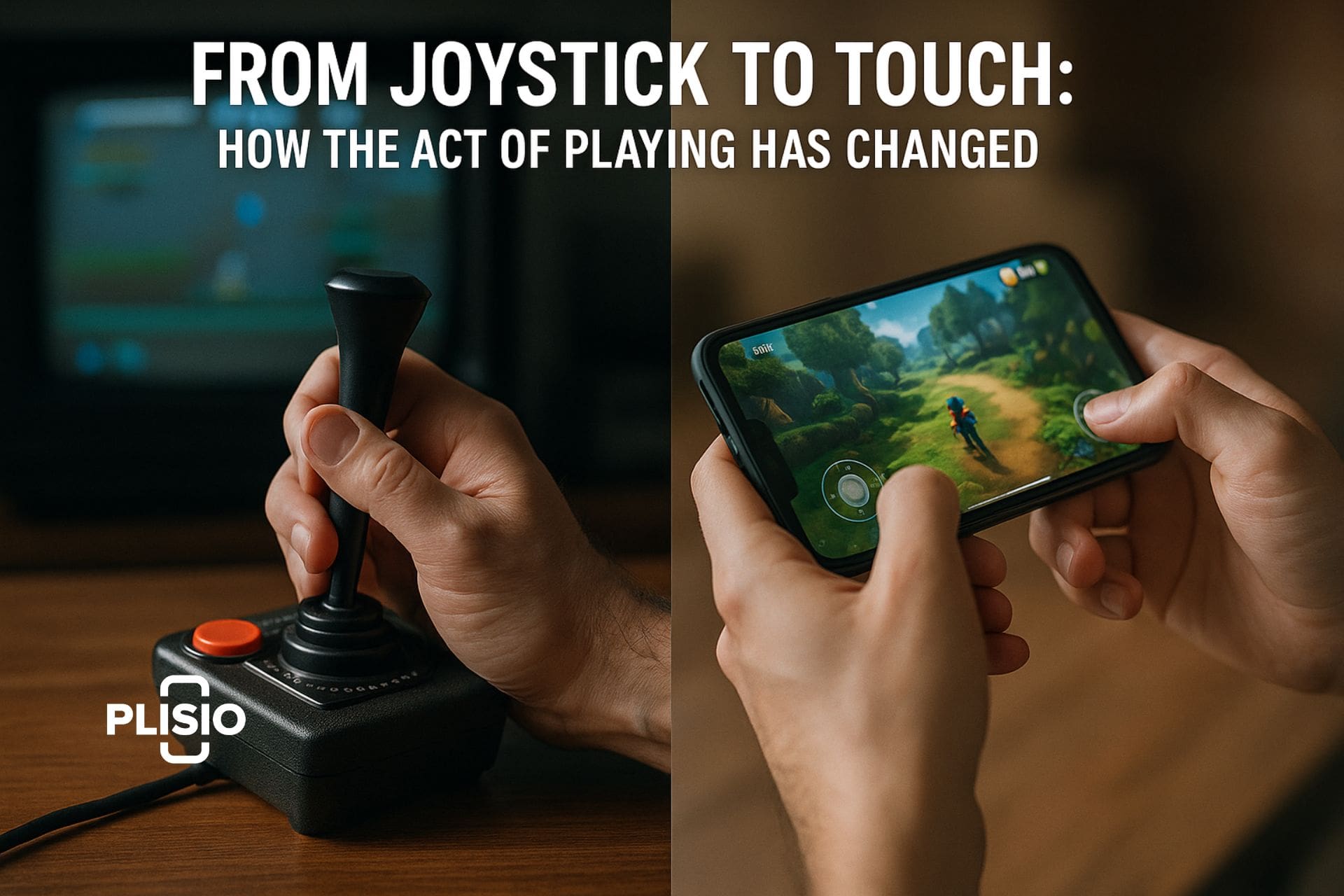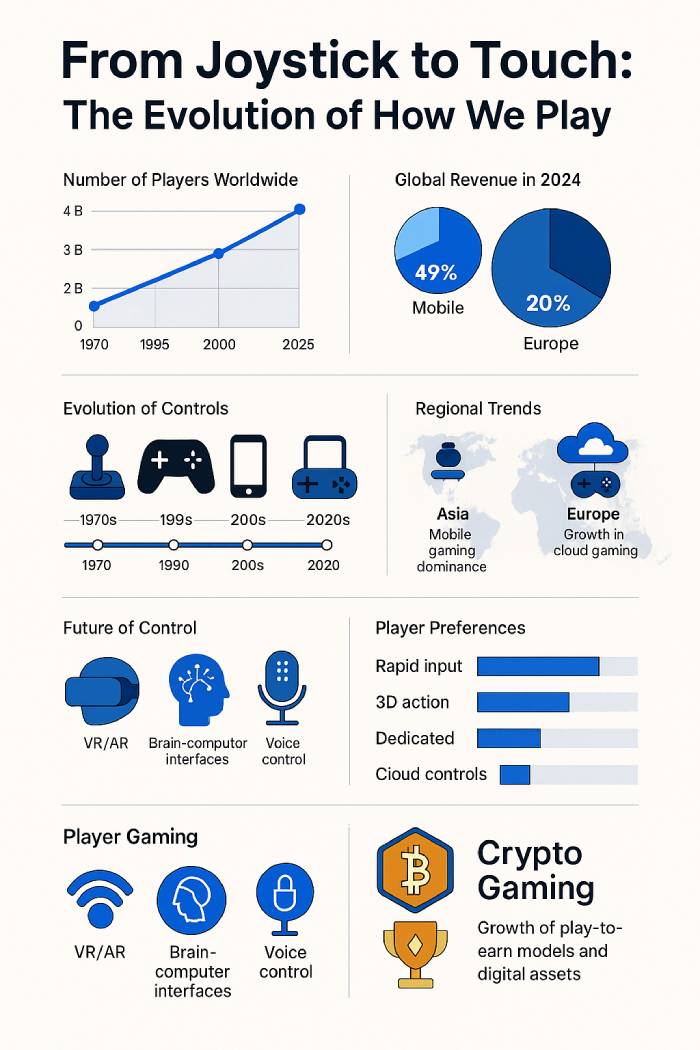From Joystick to Touch: How the Act of Playing Has Changed

For generations of gamers, “playing” meant gripping a stick topped with a red button. The joystick was an icon: simple, immediate, almost like an instinctive extension of the hand. Today, the gesture is very different. We tap, swipe, and pinch screens; we connect controllers to TVs or smartphones; sometimes, we don’t even need hardware at all thanks to cloud gaming. Looking back at the joystick’s rise and transformation helps us see how the industry shifted from hardware to software-driven experiences.
Origins: From the Skies to the Living Room
The word “joystick” was born in aviation before gaming. In the early 1900s it described the control stick of airplanes, used in the aircraft of pioneers like Louis Blériot. Only decades later did the term migrate into the world of electronic entertainment, when the first games began translating a lever’s movement into on-screen commands.
The Golden Age: Atari and the Idea of “Absolute Control”
In homes, the icon was the joystick of the Atari 2600: a digital stick with one button, clear directional inputs, and mechanical feedback that made every match a physical act. This was the era of “absolute control”: push, and the character moved; release, and it stopped. That design defined both home and arcade gaming for years.
A New Paradigm: Gamepads and Analog Control
With the arrival of gamepads, control stopped being a single dominant gesture and became a multi-finger language. The analog stick, made standard by the Nintendo 64 and Sony’s Dual Analog/DualShock controllers, ended the joystick’s monopoly. Thumb-driven movement allowed gradual precision and layouts that combined multiple actions at once—moving, aiming, jumping, adjusting the camera. From then on, the “pad with sticks” layout became the cross-platform standard.

Dematerialization: From Hardware to Services
The joystick’s decline into a niche role also reflects the market’s transformation: more and more play now happens digitally, often on personal devices. As of 2025, there are around 3.32 billion active gamers worldwide, according to industry trackers. Global gaming revenue is projected to reach nearly $200 billion this year, with digital purchases representing more than 90% of all sales in regions like Europe. Mobile remains the dominant platform, generating over $125 billion in revenue in 2025—more than any other segment—while console gaming continues to deliver strong revenue growth, underlining the balance between fixed and mobile ecosystems.
Expert View
Industry experts point out that this digital shift has permanently altered design priorities. According to Dr. Elaine Chen, a researcher in human-computer interaction, “The device is no longer the heart of the play experience—what matters is seamlessness. Whether you use a controller, touch, or voice, the goal is to reduce friction between the player’s intent and the game’s response.”
From Hand to Screen: Smartphones, Tablets, and Cloud Gaming
On mobile devices, controls are often “native touch”: virtual joysticks, swipes, gestures, and gyroscope input have become the everyday grammar of mobile play. Cloud gaming pushes this trend further: many titles now support official touchscreen layouts, removing the need for a physical controller altogether. At the same time, traditional players can still connect Xbox or PlayStation pads via Bluetooth to phones and tablets. In this online ecosystem, genres of every kind coexist—from competitive shooters to management sims, from indie creations to casino platforms—without a controller being a prerequisite.
Expert View
“The smartphone has democratized gaming in a way consoles never could,” says Luca Marino, a European market analyst. “We are looking at a generation for whom touch gestures are not a compromise but the default expectation.”
The Joystick Today: Niche, Specialized, Tactile
“Obsolete” doesn’t mean “gone.” Joysticks remain essential in flight and space simulators, where a stick (often paired with throttle, pedals, and trim controls) provides fine-tuned handling no D-pad can match. The resurgence of simulation games has fueled hardware demand—Microsoft Flight Simulator alone spurred waves of peripheral sales. Arcade sticks for fighting games and compact joysticks for travel or accessibility also keep the device relevant.
Accessibility: From One Gesture to “Your Gesture”
Another major, often overlooked shift is accessibility. Devices like the Xbox Adaptive Controller have changed the conversation from the “best controller” to the “right controller for you.” This modular system lets players connect switches, pedals, joysticks, and external buttons, tailoring controls to individual motor abilities. It shows that control evolves not only technologically, but culturally.
Expert View
As accessibility advocate Morgan Fields notes: “The most important innovation of the past decade isn’t higher resolution or faster refresh—it’s giving players of all abilities the chance to participate fully. Adaptive controllers prove that play belongs to everyone.”
Haptics and Sensation: More Than Sticks
On mainstream consoles, the latest generation has reintroduced tactile immersion. The PlayStation 5’s DualSense made haptic feedback and adaptive triggers standard, letting players feel textures, tension, and resistance through their fingers. This doesn’t put the joystick back at center stage, but it emphasizes the importance of “feeling” the game, even when the main action is just a thumb on a stick or trigger.
Regional Perspectives
The evolution of controls is also influenced by geography. In Asia-Pacific, mobile dominates, with billions of players treating smartphones as their main console. In North America, consoles remain culturally strong, with high adoption rates for PlayStation and Xbox. Europe, meanwhile, has embraced cloud services more quickly, driving digital-first revenue models. These regional shifts show that the future of input is not uniform, but adapted to local habits.
Developer Insights
Game designers are also rethinking control schemes to accommodate this diversity. According to indie developer Sarah Keane, “When I design for mobile, I think in swipes and taps first. For PC or console, it’s more about precision and simultaneous actions. The challenge is to make the same game feel natural no matter how you interact with it.” This highlights how hardware influences creativity.
Timeline of Evolution
- 1970s–1980s: Joystick era defined by Atari and arcade cabinets.
- 1990s: Rise of gamepads and the arrival of analog sticks.
- 2000s: Standardization of dual-stick layouts, wireless controllers.
- 2010s: Explosion of smartphone gaming, multitouch gestures, and VR controllers.
- 2020s: Cloud gaming, adaptive controllers, and advanced haptics.
Player Perspectives
Surveys in 2024–2025 show that around 60% of players prefer gamepads for precision, while over 70% of mobile gamers report satisfaction with touch controls. Adoption of haptic features on PlayStation 5 is also high, with a majority of users noting that adaptive triggers add immersion. This mix of preferences proves that no single method dominates—choice is the true standard.
Cultural Shifts in Play
Finally, beyond technology, the act of gaming itself has changed. In the 1980s, family living rooms revolved around a single console. Today, gaming is both solitary and social, global and personal: people play on commutes, in cafés, or in massive online worlds. The culture of play has expanded, and with it, the vocabulary of control.
Gaming and Cryptocurrencies
In recent years, gaming has become closely linked with the rise of cryptocurrencies and blockchain technology. Play-to-earn models, where gamers can earn tokens or digital assets through gameplay, have changed the perception of what it means to play. Virtual goods, once just collectibles, are now tradeable assets on blockchain marketplaces. This connection has brought a financial dimension to the gesture of play: the same controller used for entertainment can also become a tool for generating value.
Experts note that blockchain integration has influenced game design itself. Many developers now create titles with in-game economies that mirror real-world markets, where secure crypto transactions ensure transparency and ownership. This trend highlights how control devices, from touchscreens to gamepads, are not just input methods but gateways to digital economies.
From Symbol to Vocabulary
The joystick remains a symbol. But control today is a vocabulary, chosen depending on context: touch for quick input, analog pads for 3D action, flight sticks for simulators, adaptive systems when movements need to be redefined. What matters is not the shape of the controller, but the design of the experience—the ability to pull us into the game in the most natural way. In that sense, the joystick hasn’t disappeared. It has become one word in a larger gaming language—perfect in some contexts, less necessary in others. And the act of play today is precisely the freedom to choose that language.

